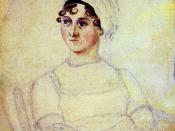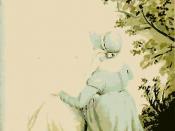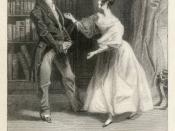Pride and Prejudice: The Effects of Context
Pride and Prejudice: The Effects of Context
Time is an unchangeable force, which alters every aspect of human life. All spheres of life are affected by time and are changed forever. In the case of Literature and Art, it is expected that a contemporary audience will tire of the older texts. This is the result of changing contexts. With these changed contexts comes changed values, changed knowledge, changed attitudes, and subsequently, changed interest in texts. Over time technology develops new ways of presenting and viewing a text; new mediums. These new mediums are often adopted to represent an older text in an attempt to appeal afresh to the changed audience. These new mediums will obviously affect the subject matter, construction and message of the text, because medium change is alteration to the original text. The novel Pride and Prejudice has endured the last two centuries with an ever-increasing popularity.
Originally composed by eighteenth century classic author Jane Austen, the novel was more recently represented in a new medium, the film medium. Simon Langton an acclaimed director was employed by the BBC to appropriate the novel into a television series.
The original medium and the changed medium are significantly impacted by the composer's context. Composer's and their texts are a reflection of the society they are created in, even if they are critical of that society. Jane Austen was certainly critical of her provincial upper/middle class society and this is evident from the subtle mocking of characters such as Catherine De Bough, a snobbish lady without morals. It is important to recognise that every single word that Jane Austen wrote was marked with her personal experiences and knowledge (just as every single frame in the television series is marked by Simon Langton's direction). Everything that she wrote down is solely Jane Austen's. The contemporary audience gets an insight into the author's mind, just as much as the author's main characters. Elizabeth Bennet, the main character, is given an omniscient wholesomeness which appeals to the audience, and reveals faults in the subordinate characters. Elizabeth is essentially Austen and they share the same position in life, the same contexts. Therefore, it can be understood that her context is embedded in the text. The similarities between Austen's novel and her own life provide an in-depth insight into her world; socially, culturally, economically, and geographically. In her novel, Jane Austen observes the social habits, customs, beliefs, attitudes and practices of eighteenth century upper class society in England. Her novel is predominantly concerned with courtship and marriage and the importance of marrying for love. She writes of families in various circumstances struggling to maintain or enhance their social position through marriage. Her characters, Elizabeth and Jane Bennet, reflect Austen's personal belief that marriage should only proceed if there is mutual affection between both persons. Jane Austen was an eighteenth century feminist, presenting her ideas to the world through prose.
In contrast, Simon Langton is a British male, who has been approached by the BBC to direct a Pride and Prejudice television series. Langton is presenting for a contemporary audience, his personal context. He is being paid handsomely, and he is expecting the text to be viewed. Langton is carrying 21st century judgemental baggage (his context), which is inherent, if only through the medium change, in the television series. Therefore it can be said that although only subtle, Langton's context, socially, culturally, economically and geographically is embedded in the film.
One of the factors that influence Austen and Langton's texts is their personal context. Austen was a feminist, a spinster; she was young, and unmarried. Austen wrote from a personal context, as can be understood from the similarities in her own life and her novel. Langton's text has been developed in a historical context. His contemporary context, of course has influence on the resultant media, yet he is not representing his own personal context in quite the same way as Austen did. Langton's production is an attempt at representing a historical text to a contemporary audience. He is appropriating an 18th century text for a 21st century audience.
Pride and Prejudice embodies Austen's social context, through the many balls, parties, and lunches of which she would have been accustomed. The connection between her social life and the Bennet daughters can be supposed to be very similar. She is writing about what she knew, and from this it can be seen she was familiar with upper class soirées and social interactions. Austen probably attended balls and dinner parties, similar to those illustrated in Pride and Prejudice. In the case of Simon Langton, he is appropriating another person's social context and time period. So, his personal context is not readily perceptible in the production. It is mainly through the social questions that he focuses on that his own social context is evident. For example, he focuses more on aspects of love and romance, as opposed to Austen who focused more on class and status.
It was due to her educated status that Austen chose, and had the ability to, compose a novel. Austen's father, who educated the sons of the gentry, imparted his literary knowledge to his daughter. The solitude of her life allowed much of her time to be dedicated to writing. She composed throughout her life many great novels and each one is more or less concerned with courtship and marriage, as was she. Her education gave her the ability to express herself through prose and the results are her novels. It can be seen that her context, as a well-educated spinster, brought to life her novels. Langton was employed due to his status as a skilled director. It can be seen that his experiences, were influential in his being chosen to direct the Pride and Prejudice series. He was no doubt chosen, for his familiarity with Jane Austen's context, because this was what he was representing. So it can be presumed he was a learned individual. Langton's familiarity with the visual audience, allowed him to create a text which was going to be interesting and lucrative.
Jane Austen's father died early on in her life and she never married. Austen, her mother, and her sister lived the remainder of their lives on the charity of her brother. She was never wealthy, however due to her brother's status, she had friends and acquaintances regarded as upper/middle class. Her knowledge of these classes in her novels can only have been from her first hand experiences. Throughout her novel, Austen's characters are often worrying about money, especially Mrs Bennet. It is most probable Mrs Bennet reflects Austen's own financial insecurities and the economic pressures she felt. Austen's self imposed spinsterhood meant she never married and therefore never elevated her economic situation. The reason that she never married is probably due to her belief that one should only marry for love. Her novel reinforces this belief and maybe this is why she never married, because she never fell in love. Austen probably wrote Pride and Prejudice without expecting its publication, let alone its incredible popularity. The novel was not published for approximately 15 years after she first wrote it. Also, the book was published anonymously and she made very little profit from its sale. Taking all this into account, it can be understood that she was writing more or less for herself, and secondarily for an audience. This is quite the opposite for Simon Langton, who logically adopted the most popular and most financially lucrative medium to represent Pride and Prejudice. He was approached to direct the series, and probably only obliged in return for money. His economic position was very different to Austen's, as he had made money from previous films. Also, Langton would have had a large film budget at his disposal to create the series. The result is the lavish costumes and settings in the series. These economic factors of both composers' contexts had influence on the resultant texts.
Austen was reasonably acquainted with the English countryside and cities; this is mainly attributed to her father's decisions to relocate at various times during her childhood. Her knowledge of cities such as London and places such as Bath is evident in her novels, as they serve as settings for some of her characters. Austen was living at a time when travel was very expensive and limited. The only transportation was by horse and cart and this was very expensive.
Langton on the other hand, is living in the age of technology, with planes and trains. The medium he is using was not even imagined when Austen wrote Pride and Prejudice. His geographical context is not as isolated, as Austen's was. The construction of Langton's text is representative of this.
Jane Austen uses literary techniques to deliver her story and present her ideas, whereas Simon Langton has employed the film medium. The reader's interpretations are subsequently different to the viewer's interpretation. Each medium has advantages and disadvantages with the restrictions they impose. For example, it could be argued that Langton's version of Pride and Prejudice is more coherent and altogether much more entertaining. However, this opinion would be from the perspective of the MTV minded generation, who are less inclined to read the original text. The pretentious learned, would state that Austen's remarkable social observation and her undeniable literary skill is much more superior than any film depiction could hope to be. It would be foolish to say one is better than the other. They are each clearly developed for different audiences, different individual experiences and therefore cannot easily be compared. Various techniques are employed by both parties to achieve their purpose. However, since their purposes were different, their techniques are different.
Austen has the power of letters, extensive dialogue and the thoughts of her characters to develop the plot and ideas. She wrote with an observant eye, delivering in detail the idiosyncrasies of her characters. The following excerpt is Austen's description of Mr Collins through the thoughts of her character Elizabeth.
"He was a tall, heavy-looking young man of five and twenty. His
air was grave and stately, and his manners were very formal."
Austen's authorial intrusion is a technique which allows her to present her personal beliefs or attitudes. Langton is unable to utilise this technique without seeming boring or obvious, because he is using a different medium. For example, the various letters in the film contain precious information that has to be leaked to the audience, however Langton could not have one of his characters read an entire letter, so he has to find a way of revealing the important parts. Having a fellow character ask what the letter speaks of does this. Even then, Langton can only reveal the important parts, as he perceives them to be, of the letter to reduce the time of the scene. Austen's prose is delightfully descriptive, and although Langton has the power of real-life imagery, sometimes this is not as beautiful or revealing as the literary imagery, that Austen creates. For example a viewer may momentarily marvel at an actor's costume, however with film, the opulence of a character's costume, cannot be overtly referred to. Austen however, could directly reference to a characters clothing and deliver a page of description, forcing the reader to acknowledge the lavishness and importance of the costume for a longer period of time. Langton's costume and setting is painstakingly authentic and the film perfectly represents the material aspects of Austen's society. Langton could take advantage of body language and symbolism, which Austen could rarely do. The score that Langton used had an incredible effect on the mood and emotions of the viewer, which cannot be as poignantly presented in prose. The visual techniques such as symbolism, camera angles and character profile, are the major factors that helped Langton communicate in a second, what might take Austen 4 or 5 pages to achieve. However, both contexts are equally effective in what they convey.
The fundamental ideas explored in both mediums are appropriately different for different audiences. Langton is more concerned with love and romance than with class and status. His context has influenced his direction. Although limited, Langton includes the lower classes in his representation, if only as background figures. This is done so as to broaden the audience. For example, the inclusion of lower classes means that Marxists would be more accepting of the series. He has chosen specifically to focus on love and romance, to remove the audience from present day dilemmas, and to avoid any negative connotations. The contemporary audience, when thinking about Pride and Prejudice, pictures a classic tale of pure love. Jane Austen, on the other hand, did not necessarily have an audience in mind. Jane Austen's novel may have been quite innocuous, however, at times the underlying message, i.e. women rarely married for love, is not necessarily happy and light. This is why each of the composers has chosen a different theme, or idea. This theme or idea has been chosen appropriately for the different audiences, the result of the composer's different contexts.
All texts are implicitly influenced and shaped by their social context and the background of the composer. Keeping this in mind, it can be understood that Jane Austen's context is embedded in her novel, and Simon Langton's context is embedded in his appropriation of her novel. Langton has attempted to convey visually what Austen demonstrated through her writing. Each text represents the society of which their creators knew and experienced. Austen, a marvellous spinster has written a wondrous story of marriage and courtship, the number one priority of her time. Langton has recreated Austen's world for a changed society by adapting Pride and Prejudice to television.


